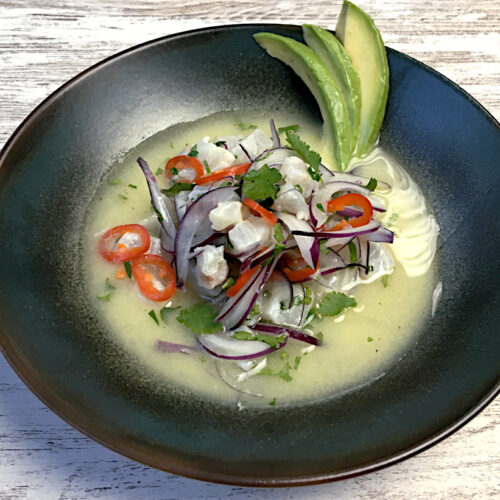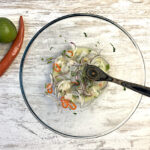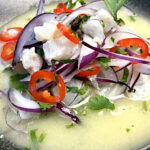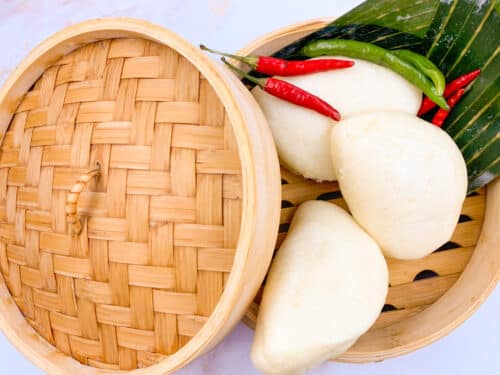
What is Ceviche and where does it come from?
Ceviche Peruano, also spelled Cebiche or Seviche, is a dish of marinated fish or seafood, from Latin America, with the origin in Peru. The Fish or Seafood is cured in an acidic marinade that contains citrus fruits, mostly lime, and is called “Leche de Tigre” (“Tigers Milk”).
When you walk on the crowded street food markets of Peru, you can see this delicious dish on every corner. The notably fresh fish is marinated in big bowls, nearly at the moment and mixed mostly with onions, coriander, chilies and often served with sweet potatoes and “choclo” a kind of Peruvian corn. The taste of the marinade is acidic and slightly to very spicy.
The origin and history of Peruvian Ceviche are not exactly clear, but in Lima/Peru, a cook from the famous Cebicheria La Mar told me a plausible history of this dish.
A long time ago when the Peruvian fisherman went out to the sea, they eventually met with fishermen from Japan and saw them eating their fish raw with rice on their boats. Adapting this method, but not being used to eat the fish raw, they marinated it with lime juice and chili and ate it with potatoes.
“Leche de Tigre”, literally translated, tigers milk, has nothing to do with a tiger and is certainly not containing its milk. I have been told that they call this marinade like that because it makes you strong like a tiger and resembles milk. They even drink this marinade like a shot as an appetizer. The best way actually, to get rid of a hangover, when you had too much pisco sour the evening before.
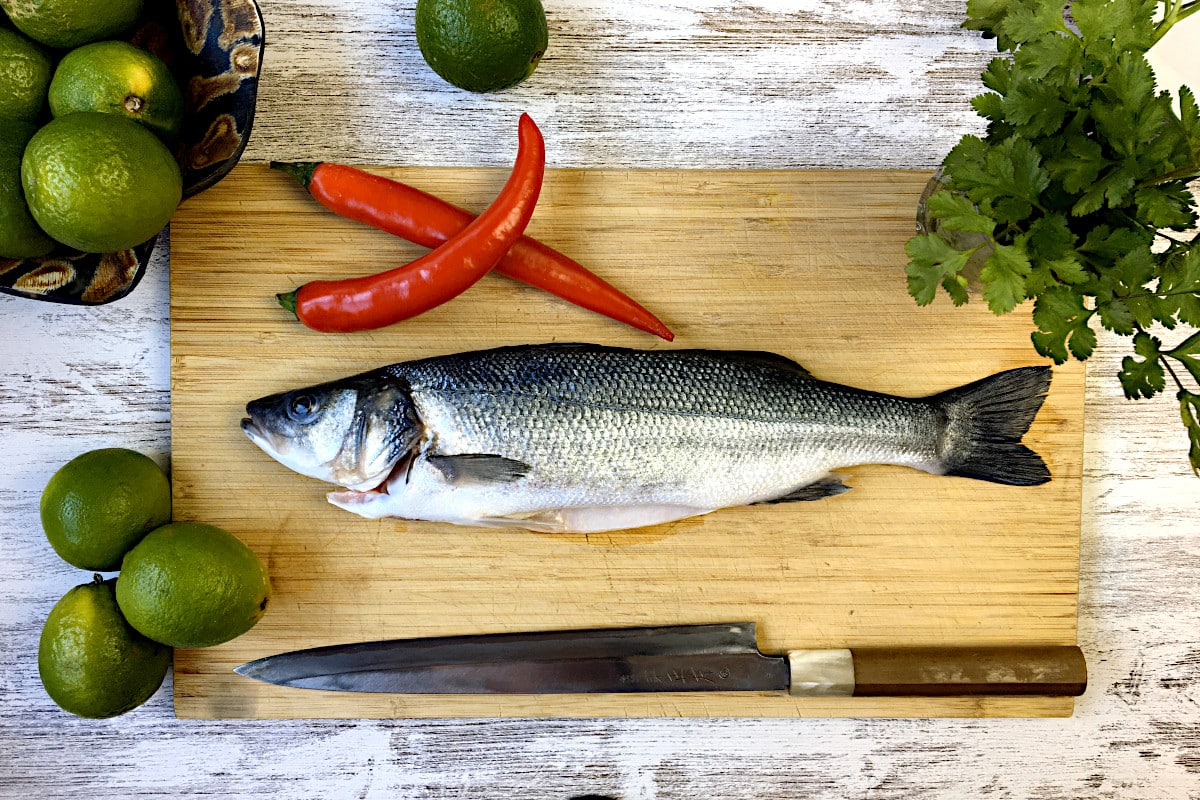
What kind of Fish to use for Ceviche Peruano?
There is no rule on which seafood or fish to use for Ceviche Peruano, and you can get creative. But it is recommended to use fish with firmer flesh and which is big enough that you can cut it into cubes of more or less 1 cm x 1cm. Also, should you always buy the freshest fish you can get, as you are going to eat it raw. Corvina, sea bass, shrimp, salmon, tuna, sole, red snapper, scallops, and octopus are all popular to use in Ceviche Peruano, but there is no limit.
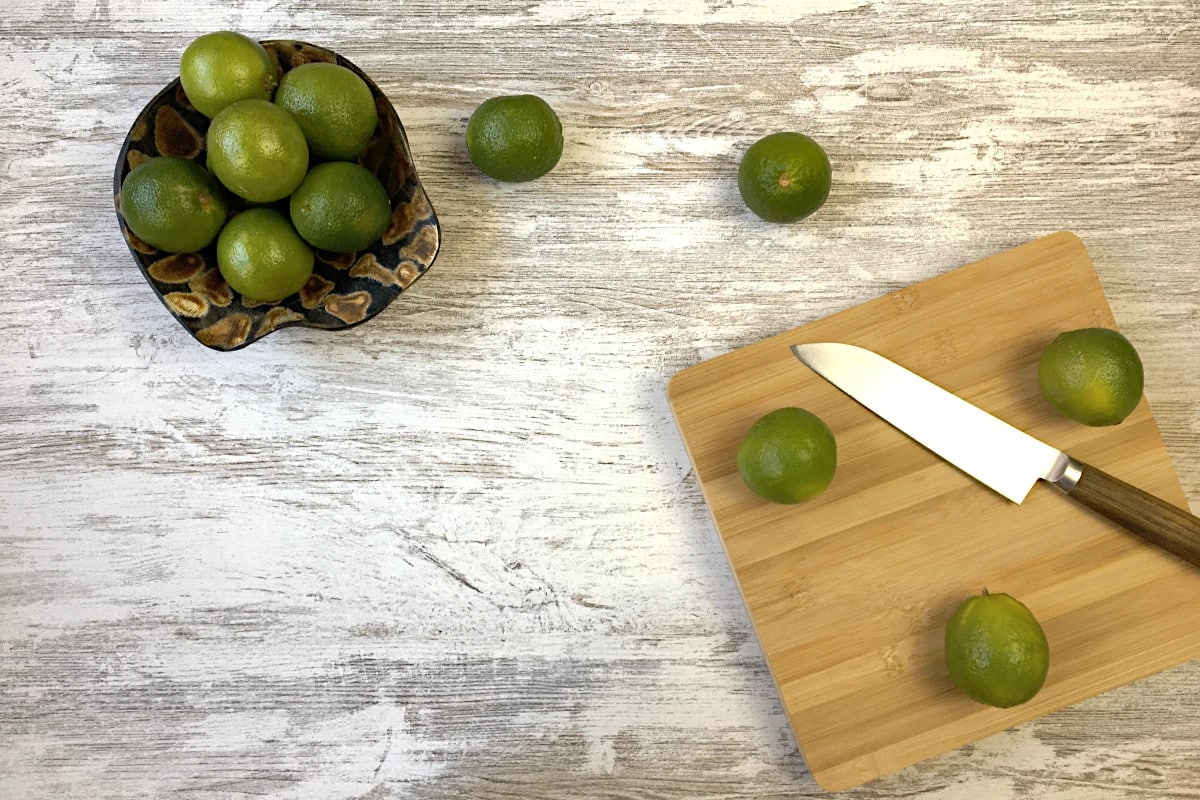
How to choose the right Limes and how to cut them for Ceviche Peruano?
Do I have to use limes for Ceviche Peruano , or can I use lemons instead? Well, there exists a lot of versions of ceviche out there, but to make a classic Ceviche Peruano, it should definitely be limes.
Choosing the right limes is very important in order to only buy fruits with plenty of juice and great flavor. It can be quite annoying when you squeeze your limes, and just a few drops of liquid come out of a hard fruit. So how do you know if the lime is good or not without cutting it?
First, look at the color of the limes. More green doesn’t necessarily mean riper. Instead, go for fruits that have a yellowish-green and often various nuances of color. Choose the limes that are shinier than the others. The more opaque the fruits are, the less ripe they are. Weight also makes a big difference. The heavier fruits usually have more juice inside. And finally, if you gently pinch them, they should be soft and give in easily.
The best way to cut limes and squeeze them is by hand. Cut the limes into three parts (like in the pictures below), leaving out the white middle part. This part in the middle is a little bitter and will alter the taste of your juice.
When you squeeze the lime, never squeeze until the last drops, because the white part near the peel also liberates bitter flavors.
Now you know one of the secrets to success for an authentic Peruvian Ceviche.
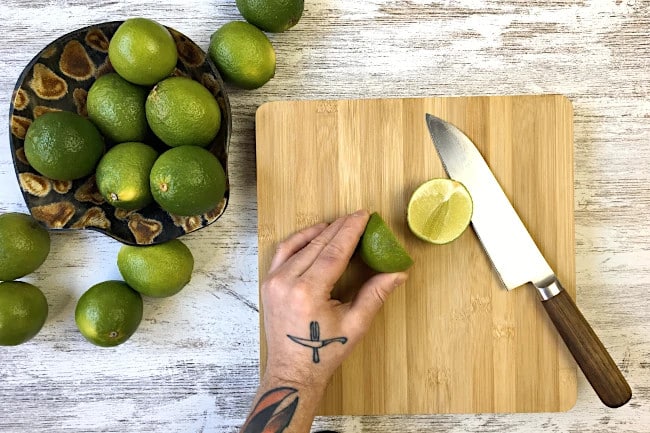
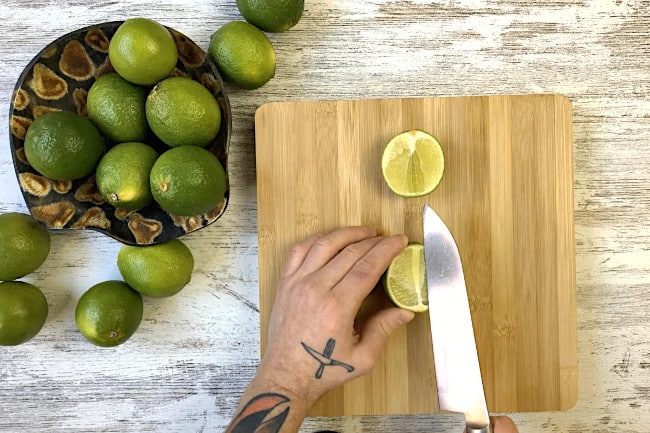


How to make “Leche de Tigre” for Ceviche Peruano?
When the fish is marinated, the acidic ingredients of the “Leche de Tigre”, cure the fish and the proteins coagulate. But the fish doesn’t get cooked and still stays raw, just turning the cubes of fish a little firmer and opaque.
“Leche de Tigre” should be always made fresh and should not be used for more than 24 hours because the lime juice changes its flavor with time, and the marinade contains raw fish protein.
Making “Leche de Tigre” is a very quick process, and all the material you need is just a mixer or food processor and a strainer.
To make this marinade authentic and tasty, you should use fish stock as shown in the recipe. Making your own fish stock
is also something really easy, and I will show you how to. If you are not up to making your own fish stock, you can always buy it from the store.
“Leche de Tigre” contains raw fish protein, which is mixed inside the marinade. You can use any kind of cheap white fish to serve your purpose, like hake or catfish for example.
Originally Peruvians use a chili called “aji limo”, “rocoto” (both very spicy) or “aji amarillo” (less spicy). Sometimes you can find these products as a paste of frozen in Latin American stores. If you can’t find any of these, use normal chilies to your liking.

How to make really easy and quick fish stock yourself?
Of course, you can buy fish stock in a shop, but it is easy and quick to make yourself, and you can keep it in your freezer to use for various dishes whenever you want. A lot of people think, making fish stock is very time-consuming and labor-intensive, but it is quite on the contrary. It will take you all together 30 minutes, and is a perfect way to utilize all the parts of the animal when buying a whole fish.
The best fish bones to use for making fish stock, are from white and mild fish. Avoid using fatty or strong tasting fish like salmon, trout or mackerel.

Learn how to make your own fish stock


Ceviche Peruano Recipe
Ceviche Peruano can be a perfect appetizer for your menu, as well as an outstanding dish when serving for your friends. The Ceviche Peruano recipe is very versatile and once you know how to make “Leche de tigre” yourself, you can pair it with a big variety of fresh fish or seafood.
This Ceviche Peruano recipe is a classic recipe, but you can be creative and bring in fruits (pineapple, lychee, grapefruit, …), vegetables (beetroots, carrots, corn, edamame …), seaweed (wakame, tosaka, hijiki, …) or other ingredients (tapioca pearls, fish eggs, …) to your liking.
Ceviche Recipe
Equipment
- blender
- strainer
Ingredients
For the "Leche de Tigre"
- 50 g onion white
- 40 g celery stalk
- 50 g fish stock
- 125 g lime juice
- 75 g white fish cheap (hake or catfish for example)
- 15 g salt
- 10 g Aji amarillo paste or chili
- 50 g ice
- 5 g coriander stems
For the Ceviche
- 400 g fish filet sea bass in this recipe
- 250 g leche de tigre
- 100 g onion red
- 1 piece of lime the juice
- 5 g salt
- 5 g ajinomoto glutamate
- 5 g coriander leafs
- 5 g chili cut, without seeds
- 1 avocado
Instructions
Leche de Tigre
- Add all the ingredients except the coriander stems into a blender and mix for approximately 1 minute until all the ingredients are dissolved.
- Add the coriander stems and mix for one second.
- Strain everything with a fine sieve, applying pressure with a spoon to press out all the liquid possible, and only reserve the liquid.
Ceviche of Sea Bass
- Cut the red onions in julienne (long thin strips) and put them into a bowl with water and ice to lose the aggressive onion flavor and get more crunchy.
- Take out all the fish bones from the fish filet and cut the filet into cubes, approximately 1 cm x 1 cm.
- Put the fish cubes into a bowl and season with salt, ajinomoto, and lime juice. Mix everything well.
- Add the onions, the leche de tigre, and mix again.
- Cut the coriander leaves and the chilies (without the seeds), add to the mixture, and stir again.
- Plate, and distribute the marinade evenly, so every plate has the same amount of letche the tigre. Cut the avocado in slices and place on the plates.



